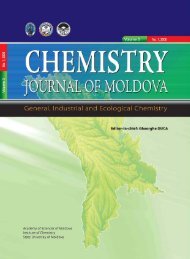2011, nr. 1 - Academia de Ştiinţe a Moldovei
2011, nr. 1 - Academia de Ştiinţe a Moldovei
2011, nr. 1 - Academia de Ştiinţe a Moldovei
You also want an ePaper? Increase the reach of your titles
YUMPU automatically turns print PDFs into web optimized ePapers that Google loves.
140<br />
<strong>de</strong> vârstă tânără cu MS în evolutie, cât și pacienţi<br />
cu MS suportată. Acestea evoluează, în majoritatea<br />
cazurilor, în sistemul vascular medular inferior,<br />
manifestându-se prin sindromul arterei spinale<br />
anterioare.<br />
2. Factorii care contribuie la <strong>de</strong>clanșarea manifestărilor<br />
neurologice medulare includ gradul<br />
unghiului cifozei, numărul segmentelor implicate,<br />
gradul <strong>de</strong> modifi care a unghiului cifozei, variantele<br />
anatomice locale, trauma și posibila lezare secundară<br />
a sistemului vascular medular prin întin<strong>de</strong>re sau<br />
compresie directă.<br />
3. Examenul prin IRM a coloanei vertebrale<br />
pune în evi<strong>de</strong>nţă stenoza canalului vertebral la<br />
nivelul cifozei toracice sau trecerii toracolombare,<br />
în combinare cu hipertrofia polisegmentară a<br />
ligamentului longitudinal posterior și a celui galben,<br />
prolabarea și hernii discale multiple, acestea<br />
cauzând <strong>de</strong>clanșarea atât a tulburărilor vasculomedulare<br />
acute, cât și a celor cronice. Localizarea<br />
<strong>de</strong> predilecţie a procesului stenotic este regiunea<br />
apexului cifotic și a trecerii toracolombare.<br />
Bibliografi e<br />
1. Ali R.M., Green D.W., Patel T.C. Scheuermann’s kyphosis.<br />
Curr. Opin. Pediatr., 1999; vol.11, 1: 70-75.<br />
2. Ballantyne E.S., Findlay G.F.G. Th oracic Spinal Stenosis.<br />
Neuro-Orthopedics 1995; vol.17/18:107-114.<br />
3. Bockeneck W.L., Bach J.R., Alba A.S. et al. Fibrocartilaginous<br />
emboli to the spinal cord: A case report. Arch.<br />
Phys. Med. Rehabil., 1990; vol. 71:754.<br />
4. Fisk J.W., Baigent M.L., Hill R.D. Inci<strong>de</strong>nce of<br />
Scheuermann’s disease. Preliminary report. Am. J. Phys.<br />
Med., 1982; vol. 61, 1. P:32-35.<br />
5. Gondim J., Ramos Junior F. Th oracic spinal cord<br />
compression at two levels due to ligamentum fl avum calcifi<br />
cation. Case report. Arg. Neuropsiquiqtr, 1998; vol.<br />
56:307-311.<br />
6. Lazorthes G.<br />
Blod supply and vascular pathology of<br />
the spinal cord. Spinal Angiomas. Ed. Pia H.W., Djindjian<br />
R., Berlin, Springer-Verlag, 1978:10.<br />
7. Murray P.M., Weinstein S.L., Spratt K.F. Th e natural<br />
history and long-term follow-up of Scheuermann’s kyphosis.<br />
J. Bone Joint Surg., 1993; vol.75-A.:236-248.<br />
8. Song KS,<br />
Yang JJ. Acutely Progressing Paraplegia<br />
Caused by Traumatic Disc Herniation through Posterior<br />
Schmorl’s No<strong>de</strong> Opening into the Spinal Canal in<br />
Lumbar Scheuermann’s Disease. Spine (Phila Pa, 1976),<br />
<strong>2011</strong>; Jan. 19.<br />
9. White A.A., Panjabi M.M. Clinical biomechanics<br />
of the spine. Second edition. Phyla<strong>de</strong>lphia: J. B. Lippincott<br />
company, 1990; 772 p.<br />
10. Wischnewski W., Pfeiffer A. Scheuermann’s<br />
disease as predisposition of later spinal disease and its<br />
effect on expert assessment in occupational disease examinations.<br />
Versicherungsmedizin, 1996; 48:126-148.<br />
Buletinul AŞM<br />
11. Wenger., Dennis R., Steven L. Scheuermann’s kyphosis.<br />
Spine, 1999; vol. 24:2630-2639.<br />
12. George A. Kapetanos,<br />
Paraskevas T. Hantzidis,<br />
Kleovoulos S., Anagnostidis and John M. Kirkos. Th oracic<br />
cord compression caused by disk herniation in Scheuermann’s<br />
disease. European Spine Journal, 2007; vol. 15, suppl 5:553-<br />
558.<br />
13. Yogana<strong>de</strong>n N., Larsen S.J., Gallagher M. Correlation<br />
of microtrauma in the spine with intraosseous pressure.<br />
Spine, 1994; vol. 19:435.<br />
14. Герман Д.Г., Скоромец А.А.,<br />
Нарушения<br />
спинномозгового кровообращения. Кишинев, 1981; 318 с.<br />
Rezumat<br />
Tulburările ischemice medulare ocupă un loc important<br />
în șirul complicaţiilor neurologice ale maladiei<br />
Scheuermann, afectând în special persoane <strong>de</strong> vârstă tânără<br />
și ducând la un <strong>de</strong>ficit neurologic invalidizant <strong>de</strong><br />
lungă durată. Studiul efectuat a <strong>de</strong>monstrat rolul modificărilor<br />
<strong>de</strong>generativ-distrofice ale coloanei vertebrale în<br />
etiopatogeneza acestora prin mecanismul <strong>de</strong> compresie<br />
vasculară sau medulară, pe fundal <strong>de</strong> stenoză a canalului<br />
vertebral la nivelul cifozei toracice sau trecerii toracolombare,<br />
în combinare cu hipertrofia polisegmentară<br />
a ligamentului longitudinal posterior și a celui galben,<br />
prolabarea și hernii discale multiple, acestea cauzând <strong>de</strong>clanșarea<br />
atât a tulburărilor vasculomedulare acute, cât<br />
și a celor cronice.<br />
Summary<br />
Ischemic spinal disturbances play an important role<br />
in the neurological complications of Scheuermann disease,<br />
aff ecting in particular young persons and leading to a longterm<br />
disabling neurological <strong>de</strong>fi cit. Our study <strong>de</strong>monstrated<br />
the role of <strong>de</strong>generative-dystrophic changes of the spine<br />
in their etiopathogenesis by mechanism of vascular or spinal<br />
compression due to stenosis of the spinal canal at the<br />
apex of thoracic kyphosis or in the thoraco-lumbar level<br />
in combination with multilevel hypertrophy of posterior<br />
longitudinal and yellow ligaments and the multiple disc<br />
herniations, these causing both acute and chronic spinalvascular<br />
disor<strong>de</strong>rs.<br />
Резюме<br />
Спинальные ишемические нарушения занимают<br />
важное место в неврологических осложнениях<br />
при болезни Шейерманн, поражая преимущественно<br />
людей молодого возраста, приводя к продолжительному<br />
инвалидизирующему неврологическому<br />
дефициту. Данное исследование выявило роль<br />
дегенеративно-дистрофических изменений позвоночника<br />
в этиопатогенезе данного заболевания в механизме<br />
сосудистой или медуллярной компрессии на<br />
фоне стеноза позвоночного канала на уровне кифоза<br />
или грудо-поясничного перехода, в комбинации с<br />
гипертрофией задней продольной и жёлтой связок и<br />
множественными грыжами дисков, вызывая острые<br />
и хронические ишемические поражения спинного<br />
мозга.

















